 The Solar System The Solar System
 Planets Planets
 Mercury Mercury
 Venus Venus
 Earth Earth
 Mars Mars
 Jupiter Jupiter
 Saturn Saturn
 Uranus Uranus
 Neptune Neptune
 Pluto Pluto
 Classification of the Planets Classification of the Planets
 Distances and Periods Distances and Periods
 Orbits and Speeds Orbits and Speeds
 Diameter, Mass, Density Diameter, Mass, Density
 Components Components
 Satellits Satellits
 Lithiosphere, Idrosphere, Atmosphere Lithiosphere, Idrosphere, Atmosphere
|
|
| Mercury |
 |
Pianeta noto agli antichi. Visibile a occhio nudo solo poco dopo il tramonto o poco prima l'alba.
Osservato da Sciapparelli nel secolo scorso e studiato da vicino nel 1974 dalla sonda Mariner 10. |
| Venus |
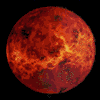 |
Pianeta noto agli antichi. Osservabile molto bene a occhio nudo verso l'alba o al tramonto.
Ricoperto da una spessa coltre di nubi e' stato studiato accuratamente da numerose sonde spaziali.
Vulcani attivi. |
| Earth |
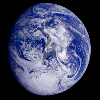 |
L'unico pianeta del sistema solare sul quale si sia sviluppata la vita. Ha un satellite di grandi dimensioni,
la Luna, un'atmosfera ed un intenso campo magnetico. Il piano della sua orbita e' detto piano dell'eclittica. |
| Mars |
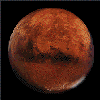 |
Pianeta noto agli antichi. 2 satelliti, Phobos e Deimos, scoperti da A. Hall nel 1877. Osservato dalle sonde
Mariner 9 nel 1971 e Viking 1 e 2 nel 1976. Vulcani spenti e vallate un tempo richhe di acqua. |
| Jupiter |
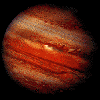 |
Pianeta noto agli antichi. Ha almeno 16 satelliti (4 galileiani, noti dal 1610) e un anello.
Fu osservato dalle sonde Pioneer 10 e 11 (1973, 1974) e Voyager 1 e 2 (1979). Ha un intenso campo magnetico
e un piccolo nucleo solido circondato da una enorme massa di idrogeno liquido. |
| Saturn |
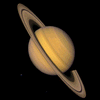 |
Pianeta noto agli antichi. Osservato da Galileo (1610) e dalle sonde Pioneer 11, Voyager 1 e 2 (1979-1981).
Ha almeno 17 satelliti, diversi migliaia di anelli e un intenso campo magnetico. Nucleo solido con un enorme
involucro di liquidi e gas. |
| Uranus |
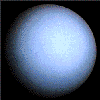 |
Scoperto da W. Herschel nel 1781. Osservato dalla sonda Voyager 2 nel 1986, possiede almeno 5 satelliti
e 10 anelli. Ha l'asse di rotazione inclinato di 98 gradi sull'eclittica. |
| Neptune |
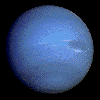 |
Scoperto da J. Galle e H. d'Arrest nel 1846 sulla base di calcoli di J.J. Le Verrier. Ha magnitudine 7.7
e quindi non puo' essere osservato a occhio nudo. Ha 8 satelliti. |
| Pluto |
 |
Scoperto da Clyde Tombaugh nel 1930. E' in realta' un pianeta doppio, la cui seconda componente, Caronte,
fu osservata nel 1978 da J. Christy. Ha un'orbita molto eccentrica e inclinata sul piano dell'eclittica
che al perielio penetra all'interno dell'orbita di Nettuno. Possiede 1 satellite. |
Classification of the Planets
Much of our concern this semester will be with the development of our present
understanding of the Solar System. We begin with a brief overview of the modern
and ancient classifications of the planets.
The Modern Solar System
The planets of the modern solar system are
grouped into several different and sometimes overlapping classifications, as
illustrated in the following figure:

- The planets inside the orbit of the earth are called the Inferior
Planets: Mercury and Venus.
- The planets outside the orbit of the earth are called the Superior
Planets: Mars, Jupiter, Saturn, Uranus, Neptune, and Pluto.
- The planets inside the asteroid belt are termed the Inner Planets
(or the Terrestrial Planets): Mercury, Venus, Earth, and Mars.
- The planets outside the asteroid belt are termed the Outer
Planets: Jupiter, Saturn, Uranus, Neptune, and Pluto.
- The planets sharing the gaseous structure of Jupiter are termed the
Gas Giant (or Jovian) Planets: Jupiter, Saturn, Uranus, and Neptune.
The 7 Planets of the Ancients
The term "planet" originally meant "wanderer": it was observed long ago that certain points of light wandered
(changed their position) with respect to the background stars in the sky. In
ancient times, before the invention of the telescope and before one understood
the present structure of the Solar System, there were thought to be 7 such
wanderers or planets: Mercury, Venus, Mars, Jupiter, Saturn, the Moon, and the Sun.
This list is different in several respects from our modern list of planets:
- The Earth is missing, because it was not understood that the points of
light wandering on the celestial sphere and the Earth on which we stood had anything in common.
- Uranus, Neptune, and Pluto are missing because they would only be
discovered when the telescope made them easily visible.
- Uranus is barely visible to the naked eye; it was discovered in 1781.
- Neptune and Pluto are too faint to see at all without a telescope; they
were discovered in 1846 and 1930, respectively.
- The Sun and the Moon were classified as planets because they wandered on
the celestial sphere, just like Mars and Jupiter and the other planets.
A central theme of our initial discussion will be how the "7 planets
of the Ancients" (only 5 of which are really planets) evolved into our present
list of Solar System planets.
Stars Look Different from Planets
Planets (and the Sun and Moon) have some observational characteristics that distinguish them from what we would now
call the stars:
| Observational Differences between Planets & Stars |
| Planets |
Stars |
| The planets move relative to stars on celestial sphere |
The relative positions of the stars are fixed on celestial sphere |
| The nearer and larger planets appear as disks in telescope |
The stars appear as "points" of light, even through the telescope |
| The brighter planets do not "twinkle" |
The stars appear to "twinkle" |
| The planets are always near the imaginary yearly path of the Sun on the celestial sphere (the ecliptic) |
Stars can be anywhere on the celestial sphere |
| Planet |
Average distance
from Sun (UA) |
Period
of Revolution |
Period
of Rotation |
| Mercury |
0.387 |
88 days |
59 days |
| Venus |
0.723 |
224.7 days |
-243 days |
| Earth |
1 (149600 Km) |
365.2425 days |
23 h 56 m 4
s |
| Mars |
1.524 |
687 days |
24 h 37 m 23 s |
| Jupiter |
5.203 |
11.86 years |
9 h 50 m 30 s |
| Saturn |
9.539 |
29.46 years |
10 h 14 m |
| Uranus |
19.18 |
84.01 years |
-11 h |
| Neptune |
30.06 |
164.8 years |
16 h |
| Pluto |
39.53 |
247.7 years |
6 days 9 h |
As discovered by Kepler, the planets orbit on ellipses with the Sun at one
focus. In addition, the planets all revolve in the same direction on their
orbits (direct orbital motion). Let's now consider the orbits of the
planets in more detail.
The Inner Solar System
Here is the inner solar system constructed with the
Solar System Live software.
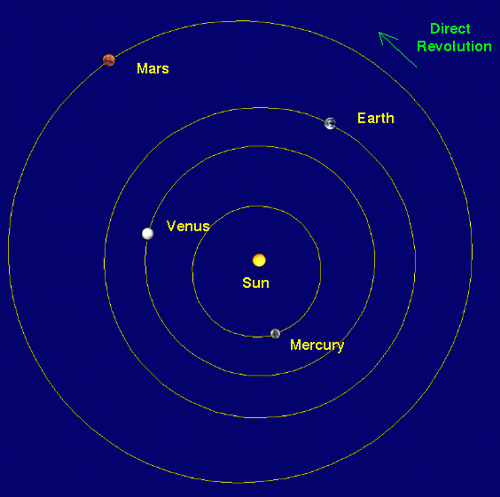 |
| The inner Solar System to scale, Fall, 1996 |
The sizes and shapes of the orbits are realistic, as is the relative
positions of the planets for the date in the Fall, 1996, when the plot was
constructed. The sizes of the planetary symbols are not to scale; the planets
would be too small to see at this scale as more than dots of light. Notice the
eccentricity of the orbits for Mercury and, to a lesser degree, Mars. From this
perspective (which corresponds to looking down on the Northern hemisphere of the
Earth), the planets all revolve in a counter-clockwise sense, as indicated by the arrow.
Here are the
present positions
(to scale) of planets in the inner solar system. In this plot, the
portion of orbit in blue is above and the portion in green is below the plane of
the ecliptic. As noted in conjunction with
Kepler's Third Law,
motion of the innermost planets is much faster than that of the outermost; this
animation
illustrates realistic motion of the inner solar system.
The preceding views represent a "top" or North perspective. Here is a side
perspective of the inner Solar System showing the tilt of the planetary orbits
with respect to the plane of the ecliptic.
 |
| Side view of the
inner Solar System, Fall, 1996 |
In this figure the white portion of the orbit is above the ecliptic plane and
the yellow portion is below. Notice that the orbits of the inner planets are
nearly, but not quite, in the same plane. The orbit of Mercury, in addition to
being the most eccentric, has the largest tilt (7 degrees) with respect to the
ecliptic plane.
The Entire Solar System
Here is the entire Solar System to scale for the orbits, also in the Fall, 1996:
 |
| The Entire Solar System to scale, Fall, 1996 |
Notice the enormous amount of empty space in the outer Solar System. To show
the entire Solar System to scale, the inner Solar System becomes so compressed
that the planet orbits almost appear to run together. The very large
eccentricity of Pluto's orbit is also obvious.
Here are the
present positions
(top view, to scale) of all planets in the Solar System. As above,
the portion of orbit in blue is above the plane of the ecliptic; portion in
green is below the plane of the ecliptic.
The following figure shows the full Solar System to scale from a side view to
illustrate the tilt of the orbits.
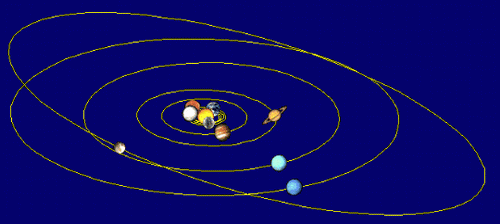 |
| Side view of entire Solar System, Fall, 1996 |
Notice that Pluto's orbit is highly tilted (17 degrees) relative to the plane
of the ecliptic.
Here is the
present position
(side view, to scale) of all planets in the Solar System. The
portion of the orbit in blue is above the plane of the ecliptic; portion in
green is below the plane of the ecliptic. View is from 20 degrees above ecliptic
plane to emphasize the tilt of orbits.
Here is the average separation of the planets from the Sun (in astronomical units) displayed in graphical form,
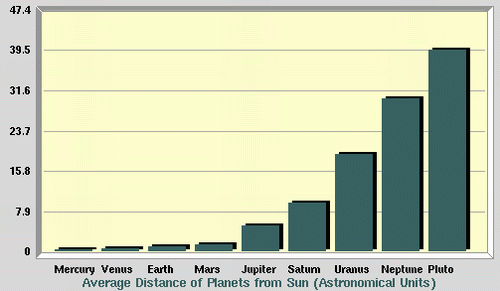
| Planet |
Tilt on Axis |
Tilt on Ellictic |
Excentricity |
Orbital speed
(Km/sec) |
Escape speed
(Km/sec) |
| Mercury |
28G |
7 |
0.26 |
47.9 |
4.2 |
| Venus |
3G |
3.39 |
0.007 |
35.1 |
10.2 |
| Earth |
23G 27' |
0 |
0.017 |
29.8 |
11.2 |
| Mars |
23G 27' |
1.85 |
0.093 |
24.1 |
5 |
| Jupiter |
3G 5' |
1.3 |
0.048 |
13.1 |
61 |
| Saturn |
26G 44' |
2.49 |
0.056 |
9.6 |
37 |
| Uranus |
97.9G |
0.77 |
0.047 |
6.8 |
22 |
| Neptune |
28G 48' |
1.77 |
0.009 |
5.4 |
25 |
| Pluto |
? |
17.15 |
0.248 |
4.7 |
10 |
Here are the eccentricities of the planetary orbits

Last two graphs display clearly the enormous distances in the outer Solar
System, and that Pluto and Mercury have by far the most elliptical orbits.
| Planet |
Equatorial diameter
(Km) |
Mass
(10^24 Kg) |
Volume
(Earth=1) |
Density
(g/m3) |
| Mercury |
4880 |
.32 |
.06 |
5.3 |
| Venus |
12104 |
4.87 |
.88 |
4.95 |
| Earth |
12756 |
5.98 |
1 |
5.52 |
| Mars |
6787 |
.64 |
.15 |
3.95 |
| Jupiter |
142800 |
1900 |
1316 |
1.33 |
| Saturn |
119300 |
570 |
755 |
.7 |
| Uranus |
47100 |
86.8 |
67 |
1.56 |
| Neptune |
44600 |
103 |
57 |
2.28 |
| Pluto |
6000 |
0.0129 |
4 |
.25 |
There are many popular misconceptions concerning the size and scale of
objects in the Solar System. These mostly have to do with a failure to realize
the relative radii of planets and the Sun, and the failure to appreciate how
large the outer solar system is relative to the inner solar system.
The Sun and the gas giant planets like Jupiter are by far the largest objects in the Solar System. The
other planets are small specks on this scale, as the following figure illustrates.
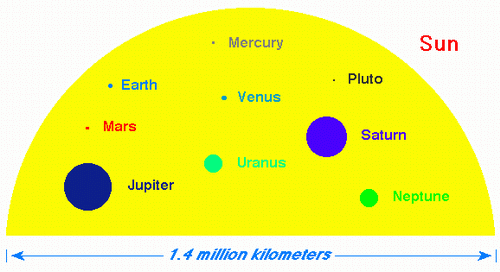 |
| The Sun and planets drawn to scale |
Indeed, on this scale the smaller planets like Pluto and Mercury are barely visible.
The masses of the planets are also concentrated in
the Gas Giant planets Jupiter, Saturn, Uranus, and Neptune, as the following graph indicates.

However, the large mass of these planets comes from their absolute sizes, not
their densities. The inner planets are by far the most dense, as the following graph indicates:
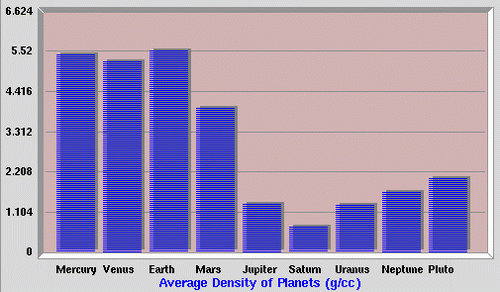
This distribution of masses and densities in the Solar System is a
key observation that a theory of the origin of the Solar System must explain.
Here is an
astrophysical calculator
that will display basic astronomical constants and solar system
data at the touch of a button, and also allow calculations using these quantities.
| Planet |
Main components
of atmosphere |
Gravity
(m/sec2) |
Temperature
(Kelvin) |
| Mercury |
trace of Hydrogen and Helium |
3.6 |
452 |
| Venus |
96% Carbon Dioxide
3% Nitrogen
1.6% Argon |
8.5 |
726 |
| Earth |
78% Nitrogen
21% Oxigen
1% Argon |
9.81 |
281-310-260 |
| Mars |
95% Carbon Dioxide
3% Nitrogen
1.6% Argon |
3.8 |
310-150 |
| Jupiter |
90% Hydrogen
10% Helium
0.07% Methane |
26 |
120 |
| Saturn |
97% Hydrogen
3% Helium
0.05% Methane |
11.2 |
88 |
| Uranus |
83% Hydrogen
15% Helium
2% Methane |
9.4 |
59 |
| Neptune |
74% Hydrogen
25% Helium
1% Methane |
15 |
48 |
| Pluto |
Perhaps Methane and Nytrogen |
8 |
37 |
| Planet |
Satellit |
Average distance
from Planet
(10^3 Km) |
Sideral period
(days/hrs) |
Diameter
(Km) |
Surface area
(10^3 Km2) |
Actraction ratio |
Propriety |
Date of
discovery |
| Mercury |
|
|
|
|
|
|
|
|
| Venus |
|
|
|
|
|
|
|
|
| Earth |
Moon |
384 |
27/08 |
3470 |
37851 |
.46 |
own |
|
| Mars |
Phobos
Deimos |
9
24 |
0/08
1/06 |
24
13 |
1.7
0.46 |
195
32 |
own
own |
1877
1877 |
| Jupiter |
Amaltea
Io
Europa
Ganimede
Callisto
Decimo
Sesto
Settimo
Dodicesimo
Undicesimo
Ottavo
Nono
|
180
420
670
1070
1880
11900
11980
12280
21200
22600
23500
23700 |
0/12
1/18
3/13
7/04
16/17
264
266
276
625
695
739
758 |
240
3700
3140
5140
5170
24
160
56
23
31
25
27 |
81
43674
30995
83123
84532
.81
41
7.6
1.7
1.7
7.6
1.7 |
18200
3260
1260
490
160
4.4
4.3
4.2
1.3
1.2
1.03
1.03
| own
own
own
own
own
captured
captured
captured
captured
captured
captured
captured
| 1892
1610
1610
1610
1610
1938
1904
1905
1951
1938
1908
1914 |
| Saturn |
Giano
Mimas
Enceladus
Tethys
Dione
Rhea
Titan
Hyperion
Iapetus
Phoebe |
158
190
240
295
380
530
1220
1480
3560
12960 |
0/18
0/23
1/09
1/21
2/18
4/12
15/23
21/07
79/08
550/26 |
300
500
600
1300
1200
1800
5000
400
1200
140 |
734
734
3940
3940
8077
68564
326
5184
326 |
23000
15500
9800
6400
4150
2000
380
260
45
3.5 |
own
own
own
own
own
own
own
own
own
captured |
1967
1789
1789
1684
1684
1672
1655
1848
1671
1898 |
| Uranus |
Miranda
Ariel
Umbriel
Titania
Oberon |
125
190
265
440
590 |
1/10
2/12
4/03
8/17
13/11 |
200
900
700
1700
1600 |
52
734
512
2912
2912 |
24600
9850
4750
1750
1050 |
own
own
own
own
own |
1948
1851
1851
1787
1787 |
| Neptune |
Triton
Nereid |
350
5570 |
5/21
359/10 |
5000
300 |
63868
140 |
8400
24 |
own
captured |
1846
1949 |
| Pluto |
Charon |
|
|
|
|
|
|
1978 |
| Planet |
Lithiosphere
(ray in Km) |
Idrosphere
(thickness in Km) |
Atmosphere
(thickness in Km) |
| Earth |
6400 |
3.3 |
12.9 |
| Jupiter |
29800 |
27400 |
12900 |
| Saturn |
22500 |
12900 |
25700 |
| Uran |
11300 |
9700 |
4800 |
| Neptun |
9700 |
9700 |
3200 |
|





